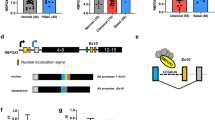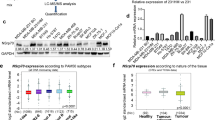Abstract
RRP1B (ribosomal RNA processing 1 homolog B) was first identified as a metastasis susceptibility gene in breast cancer through its ability to modulate gene expression in a manner that can be used to accurately predict prognosis in breast cancer. However, the mechanism(s) by which RRP1B modulates gene expression is currently unclear. Many RRP1B binding candidates are involved in alternative splicing, a mechanism of gene expression regulation that is increasingly recognized to be involved in cancer progression and metastasis. One such target is SRSF1 (serine/arginine-rich splicing factor 1) (SF2/ASF, splicing factor 2/alternative splicing factor), an essential splicing regulator that also functions as an oncoprotein. Earlier studies demonstrated that splicing and transcription occur concurrently and are coupled processes. Given that RRP1B regulates transcriptional activity, we hypothesized that RRP1B also regulates the expression of alternative mRNA isoforms through its interaction with SRSF1. Interaction between RRP1B and SRSF1 was verified by coimmunoprecipitation and coimmunofluorescence. Treatment of cells with transcriptional inhibitors significantly increased this interaction, demonstrating that the association of these two proteins is transcriptionally regulated. To assess the role of RRP1B in the regulation of alternative isoform expression, RNA-sequencing data were generated from control and Rrp1b-knockdown cells. Knockdown of Rrp1b induced a significant change in isoform expression in over 600 genes compared with control cell lines. This was verified by quantitative reverse-transcription PCR using isoform-specific primers. Pathway enrichment analyses identified cell cycle and checkpoint regulation to be those most affected by Rrp1b knockdown. These data suggest that RRP1B suppresses metastatic progression by altering the transcriptome through its interaction with splicing regulators such as SRSF1.
This is a preview of subscription content, access via your institution
Access options
Subscribe to this journal
Receive 50 print issues and online access
$259.00 per year
only $5.18 per issue
Buy this article
- Purchase on Springer Link
- Instant access to full article PDF
Prices may be subject to local taxes which are calculated during checkout






Similar content being viewed by others
References
Crawford NP, Qian X, Ziogas A, Papageorge AG, Boersma BJ, Walker RC et al. Rrp1b, a new candidate susceptibility gene for breast cancer progression and metastasis. PLoS Genet 2007; 3: e214.
Ramaswamy S, Ross KN, Lander ES, Golub TR . A molecular signature of metastasis in primary solid tumors. Nat Genet 2003; 33: 49–54.
van de Vijver MJ, He YD, van't Veer LJ, Dai H, Hart AA, Voskuil DW et al. A gene-expression signature as a predictor of survival in breast cancer. N Engl J Med 2002; 347: 1999–2009.
Hsieh SM, Look MP, Sieuwerts AM, Foekens JA, Hunter KW . Distinct inherited metastasis susceptibility exists for different breast cancer subtypes: a prognosis study. Breast Cancer Res 2009; 11: R75.
Crawford NP, Yang H, Mattaini KR, Hunter KW . The metastasis efficiency modifier ribosomal RNA processing 1 homolog B (RRP1B) is a chromatin-associated factor. J Biol Chem 2009; 284: 28660–28673.
Chamousset D, De Wever V, Moorhead GB, Chen Y, Boisvert FM, Lamond AI et al. RRP1B targets PP1 to mammalian cell nucleoli and is associated with Pre-60S ribosomal subunits. Mol Biol Cell 2010; 21: 4212–4226.
Wu JY, Maniatis T . Specific interactions between proteins implicated in splice site selection and regulated alternative splicing. Cell 1993; 75: 1061–1070.
Krainer AR, Conway GC, Kozak D . The essential pre-mRNA splicing factor SF2 influences 5' splice site selection by activating proximal sites. Cell 1990; 62: 35–42.
Zuo P, Manley JL . Functional domains of the human splicing factor ASF/SF2. EMBO J. 1993; 12: 4727–4737.
Puig O, Bragado-Nilsson E, Koski T, Seraphin B . The U1 snRNP-associated factor Luc7p affects 5' splice site selection in yeast and human. Nucleic Acids Res 2007; 35: 5874–5885.
Umehara H, Nishii Y, Morishima M, Kakehi Y, Kioka N, Amachi T et al. Effect of cisplatin treatment on speckled distribution of a serine/arginine-rich nuclear protein CROP/Luc7A. Biochem Biophys Res Commun 2003; 301: 324–329.
Venables JP . Aberrant and alternative splicing in cancer. Cancer Res 2004; 64: 7647–7654.
Kim E, Goren A, Ast G . Insights into the connection between cancer and alternative splicing. Trends Genet 2008; 24: 7–10.
Xu Q, Lee C . Discovery of novel splice forms and functional analysis of cancer-specific alternative splicing in human expressed sequences. Nucleic Acids Res 2003; 31: 5635–5643.
Wang Z, Lo HS, Yang H, Gere S, Hu Y, Buetow KH et al. Computational analysis and experimental validation of tumor-associated alternative RNA splicing in human cancer. Cancer Res 2003; 63: 655–657.
Hui L, Zhang X, Wu X, Lin Z, Wang Q, Li Y et al. Identification of alternatively spliced mRNA variants related to cancers by genome-wide ESTs alignment. Oncogene 2004; 23: 3013–3023.
Wang GS, Cooper TA . Splicing in disease: disruption of the splicing code and the decoding machinery. Nat Rev Genet 2007; 8: 749–761.
Karni R, de Stanchina E, Lowe SW, Sinha R, Mu D, Krainer AR . The gene encoding the splicing factor SF2/ASF is a proto-oncogene. Nat Struct Mol Biol 2007; 14: 185–193.
Carrillo Oesterreich F, Preibisch S, Neugebauer KM . Global analysis of nascent RNA reveals transcriptional pausing in terminal exons. Mol Cell 2010; 40: 571–581.
Alexander RD, Innocente SA, Barrass JD, Beggs JD . Splicing-dependent RNA polymerase pausing in yeast. Mol Cell 2010; 40: 582–593.
Ip JY, Schmidt D, Pan Q, Ramani AK, Fraser AG, Odom DT et al. Global impact of RNA polymerase II elongation inhibition on alternative splicing regulation. Genome Res 2011; 21: 390–401.
Luco RF, Pan Q, Tominaga K, Blencowe BJ, Pereira-Smith OM, Misteli T . Regulation of alternative splicing by histone modifications. Science 2010; 327: 996–1000.
Vargas DY, Shah K, Batish M, Levandoski M, Sinha S, Marras SA et al. Single-molecule imaging of transcriptionally coupled and uncoupled splicing. Cell 2011; 147: 1054–1065.
Baumli S, Endicott JA, Johnson LN . Halogen bonds form the basis for selective P-TEFb inhibition by DRB. Chem Biol 2010; 17: 931–936.
Trask DK, Muller MT . Stabilization of type I topoisomerase-DNA covalent complexes by actinomycin D. Proc Natl Acad Sci USA 1988; 85: 1417–1421.
Bensaude O . Inhibiting eukaryotic transcription: which compound to choose? How to evaluate its activity? Transcription 2011; 2: 103–108.
Pei XF, Noble MS, Davoli MA, Rosfjord E, Tilli MT, Furth PA et al. Explant-cell culture of primary mammary tumors from MMTV-c-Myc transgenic mice. In Vitro Cell Dev Biol Anim 2004; 40: 14–21.
Aslakson CJ, Miller FR . Selective events in the metastatic process defined by analysis of the sequential dissemination of subpopulations of a mouse mammary tumor. Cancer Res 1992; 52: 1399–1405.
Piva F, Giulietti M, Nocchi L, Principato G . SpliceAid: a database of experimental RNA target motifs bound by splicing proteins in humans. Bioinformatics 2009; 25: 1211–1213.
Bagga PS, Ford LP, Chen F, Wilusz J . The G-rich auxiliary downstream element has distinct sequence and position requirements and mediates efficient 3' end pre-mRNA processing through a trans-acting factor. Nucleic Acids Res 1995; 23: 1625–1631.
Arhin GK, Boots M, Bagga PS, Milcarek C, Wilusz J . Downstream sequence elements with different affinities for the hnRNP H/H' protein influence the processing efficiency of mammalian polyadenylation signals. Nucleic Acids Res 2002; 30: 1842–1850.
Du K, Leu JI, Peng Y, Taub R . Transcriptional upregulation of the delayed early gene HRS/SRp40 during liver regeneration. Interactions among YY1, GA-binding proteins, and mitogenic signals. J Biol Chem 1998; 273: 35208–35215.
Zahler AM, Neugebauer KM, Lane WS, Roth MB . Distinct functions of SR proteins in alternative pre-mRNA splicing. Science 1993; 260: 219–222.
Yeo G, Holste D, Kreiman G, Burge CB . Variation in alternative splicing across human tissues. Genome Biol 2004; 5: R74.
Yeo GW, Van Nostrand E, Holste D, Poggio T, Burge CB . Identification and analysis of alternative splicing events conserved in human and mouse. Proc Natl Acad Sci USA 2005; 102: 2850–2855.
Lemischka IR, Pritsker M . Alternative splicing increases complexity of stem cell transcriptome. Cell Cycle 2006; 5: 347–351.
Nurtdinov RN, Artamonova II, Mironov AA, Gelfand MS . Low conservation of alternative splicing patterns in the human and mouse genomes. Hum Mol Genet 2003; 12: 1313–1320.
Venables JP . Unbalanced alternative splicing and its significance in cancer. Bioessays 2006; 28: 378–386.
Lee JH, Horak CE, Khanna C, Meng Z, Yu LR, Veenstra TD et al. Alterations in Gemin5 expression contribute to alternative mRNA splicing patterns and tumor cell motility. Cancer Res 2008; 68: 639–644.
Grosso AR, Martins S, Carmo-Fonseca M . The emerging role of splicing factors in cancer. EMBO Rep 2008; 9: 1087–1093.
Wang ET, Sandberg R, Luo S, Khrebtukova I, Zhang L, Mayr C et al. Alternative isoform regulation in human tissue transcriptomes. Nature 2008; 456: 470–476.
Albulescu LO, Sabet N, Gudipati M, Stepankiw N, Bergman ZJ, Huffaker TC et al. A quantitative, high-throughput reverse genetic screen reveals novel connections between pre-mRNA splicing and 5' and 3' end transcript determinants. PLoS Genet 2012; 8: e1002530.
Thorsen K, Sorensen KD, Brems-Eskildsen AS, Modin C, Gaustadnes M, Hein AM et al. Alternative splicing in colon, bladder, and prostate cancer identified by exon array analysis. Mol Cell Proteomics 2008; 7: 1214–1224.
Venables JP, Klinck R, Koh C, Gervais-Bird J, Bramard A, Inkel L et al. Cancer-associated regulation of alternative splicing. Nat Struct Mol Biol 2009; 16: 670–676.
Trapnell C, Pachter L, Salzberg SL . TopHat: discovering splice junctions with RNA-Seq. Bioinformatics 2009; 25: 1105–1111.
Trapnell C, Williams BA, Pertea G, Mortazavi A, Kwan G, van Baren MJ et al. Transcript assembly and quantification by RNA-Seq reveals unannotated transcripts and isoform switching during cell differentiation. Nat Biotechnol 2010; 28: 511–515.
Roberts A, Trapnell C, Donaghey J, Rinn JL, Pachter L . Improving RNA-Seq expression estimates by correcting for fragment bias. Genome Biol 2011; 12: R22.
Acknowledgements
This work was supported by the Intramural Research Program of the National Human Genome Research Institute, National Institutes of Health, USA. We thank Stephen Wincovitch and Sujata Bupp for technical assistance, and Drs Kent Hunter, Tom Misteli and Larry Brody for critical review of the manuscript.
Author information
Authors and Affiliations
Consortia
Corresponding author
Ethics declarations
Competing interests
The authors declare no conflict of interest.
Additional information
Supplementary Information accompanies this paper on the Oncogene website
Rights and permissions
About this article
Cite this article
Lee, M., Dworkin, A., Gildea, D. et al. RRP1B is a metastasis modifier that regulates the expression of alternative mRNA isoforms through interactions with SRSF1. Oncogene 33, 1818–1827 (2014). https://doi.org/10.1038/onc.2013.133
Received:
Revised:
Accepted:
Published:
Issue Date:
DOI: https://doi.org/10.1038/onc.2013.133
Keywords
This article is cited by
-
In-depth analysis of alternative splicing landscape in multiple myeloma and potential role of dysregulated splicing factors
Blood Cancer Journal (2022)
-
GNL3 and SKA3 are novel prostate cancer metastasis susceptibility genes
Clinical & Experimental Metastasis (2015)
-
Cisplatin and paclitaxel target significant long noncoding RNAs in laryngeal squamous cell carcinoma
Medical Oncology (2014)



